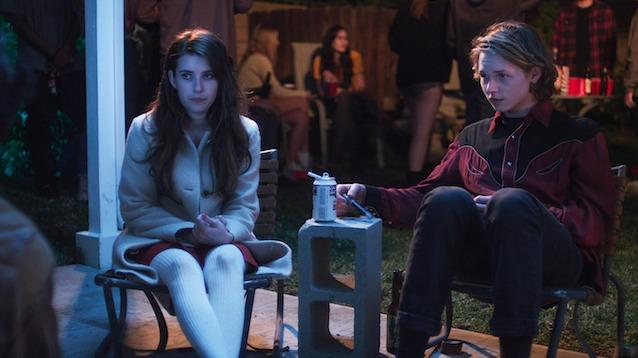First published in Daily Life, August 21, 2014
The only thing worse than being jolted out of a dream is the moment you realise that it’s devolved into a nightmare.
In Palo Alto – a movie where washed-out colours, fleeting moments and a bittersweet soundtrack by Blood Orange’s Dev Hynes conjure a sense of teenage listlessness that feels as if director Gia Coppola has plucked your memories out of the air and bottled them on film – the moment comes when April, Fred and Teddy, the movie’s protagonists, abandon the predictable thrills of a high school party to dissect the suicide of a former classmate in a way that’s both oddly familiar and shockingly cavalier. “His parents pressured the shit out of him because he was Asian,” deadpans Fred, whose habit of driving cars into walls for kicks hints that he could do with some parental pressure. And when he’s met with a confused glance from April, he ends the debate with a powerful declaration: “I don’t think you’d know any better than me.”
This telling piece of dialogue, which will either see you nod knowingly or have the heart-stabbing impact of hearing a friend talk about you behind your back, is absent from the glowing response to Palo Alto, thanks to the fact that the film is both a light-years improvement on the James Franco short-story collection from which it’s adapted and the way it’s a textbook narrative of wasted youth. As The New York Times’ Manohla Dargis points out, Palo Alto’s characters “aren’t the tireless achievers cramming for tests and preparing for college” but “the anxious children who have – since the likes of Holden Caulfield and James Dean’s rebel – defined American adolescence as a state of poetic confusion.”
Brett Easton Ellis’ The Rules of Attraction. Larry Clark’s Kids. Almost everything by Sofia Coppola or Gus Van Sant. The shape of this poetic confusion – whether it concerns debauched undergrads with morality issues, drug-addled nineties’ skateboarders or millennial narcissists with rich-kid problems – is less important than its message: that losing your way is the necessary consequence of being young. It also implies that veering off the path – even if your suburban foibles didn’t involve college orgies, a heroin addiction or falling for a creepy older man (Franco) as April does in Palo Alto – can help you learn the difference between a good and bad decision and acquire the wisdom that’s central to becoming a functioning adult.
The wasted youth narrative doesn’t capture the messiness of being young as much as it shows us what being young is for. Stories of adolescent confusion inspire countless retellings (Clark is making another Kids, set in Paris) and resonate not because they’re wildly original but because we need popular culture to tell us, as Dargis writes, that “this incompleteness will give way to a sense of wholeness” and that the mistakes that we make on the way to finding ourselves are actually okay.
In a July 2014 review in The Rumpus, Joe Sacksteder linked the success of Palo Alto – whose characters chain-smoke, use sex as a means for finding love and drink-drive before retreating to their childhood bedrooms – to this thrill of recognition. “There might be imperfections in Coppola’s execution, but what comes from the vigorous spontaneity of her attack is probably the closest we upper-class, white, MFA students will get to really remembering those weird years before we became smart and responsible and tightly edited,” he writes.
But you don’t have to be white to remember those weird years before you became smart and responsible and tightly edited. The pain and pleasures of taking wrong turns, being self-destructive in order to create something and doing things that aren’t you to find out who you are aren’t specific to race – they’re just a consequence of being young. If the nameless Asian kid in Palo Alto – a film that, like every instance of the trope, features all-white characters – was given a chance to be more than a teenage prodigy who crumbled under the weight of parental pressure, he’d be at the same party as April, Fred and Teddy, making every effort to lose himself so that one day he might be found.
Nonwhite people get their own wasted youth narratives although they tend to involve a lot more caricature and much less poetry. They include films such as coming-of-age classics like Dangerous Minds and Poetic Justice, or gritty realist portraits such asKidulthood, where characters’ journeys are obscured by the struggles that come with being born with a certain skin colour in a particular time and place. Or they’re nerdy narrative foils for white characters’ dilemmas, a pathology – called out by Ayesha Siddiqi in a Vice essay on MIA – that trades on “just happy-to-be-here spelling bee champions and accented sidekicks.”
In an essay in The Rumpus, critic Roxane Gay elevates the case for on-screen diversity beyond tired conversations about quotas and political correctness and makes a case for why it’s urgent that nonwhite people see the full spectrum of our experiences captured on screen.
“We want, and rightly so, to believe our lives deserve to be new, relatable, and important. We want to see more complex, nuanced depictions of what it really means to be whoever we are or were or hope to be,” she writes.
When it comes to wasted youth narratives, it’s hard to tell how long we’ll be waiting.
